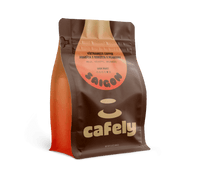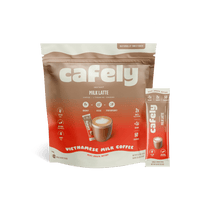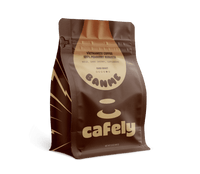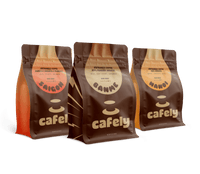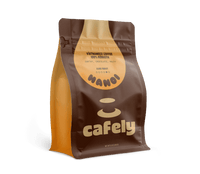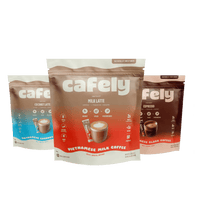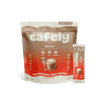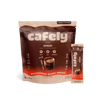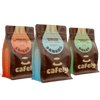You don’t have to waste leftover coffee — it can be reheated. However, improper storage and reheating can cause the flavor to deteriorate, leading to a bitter, stale-tasting cup. If you’ve ever wondered how long coffee can sit out before going bad, the key is to store it correctly and reheat it properly.
With that said, if you follow the correct steps, you can preserve most of the flavor and avoid wasting a good pot of coffee.
In this article, you’ll learn how to reheat coffee properly using two different methods. We also have some storage tips, so you can preserve any leftover brew mid to long-term.
How to Reheat Coffee on the Stove (Best Way)

Reheating coffee in a pan on the stove provides the most control over temperature and the time it takes to warm through the liquid. This control allows you to warm the coffee slowly and evenly, resulting in a better-tasting brew.
Here's how to reheat your leftover coffee on the stove:
What You’ll Need:
- Small Saucepan — A stainless steel or nonstick pan works best.
- Wooden Spoon or Silicone Spatula — For gentle stirring.
- Room Temperature or Refrigerated Coffee — From a previously brewed batch.
- Stovetop Burner — Gas, induction, or electric will all work fine.
1. Add the Coffee to the Pan
Pour your leftover coffee into a small saucepan. Make sure you don’t fill it to the rim so you can stir it easily without spilling the coffee.
2. Heat on a Low Setting
Set your stove to a low to medium-low heat. Reheating slowly avoids scalding the coffee and altering its flavor.
3. Stir Regularly
Using a wooden spoon or silicone spatula, gently stir the coffee as it heats. Regularly stirring the coffee while it warms through ensures it warms evenly. It also prevents scorching at the bottom of the pan where the fine grounds settle.
4. Remove From the Heat
As soon as the coffee reaches drinking temperature, remove it from the heat and pour it into your mug. Avoid boiling the coffee — make sure to remove it from the heat before the brew starts to simmer. Allowing the reheated coffee to boil will turn it bitter.
How to Reheat Coffee in the Microwave (Fastest Way)
Using a microwave is a convenient way to reheat leftover coffee quickly. While it’s not as good as using a stove, if you follow the correct steps, you can prevent overheating and flavor loss.
Here’s how to reheat coffee in a microwave without ruining its characteristics:
What You'll Need:
- Microwave-Safe Mug — Ceramic or glass mugs work best.
- Room Temperature or Cold Coffee — Left over from a previous brew.
- Microwave Oven — Any standard microwave.
- Spoon — For stirring regularly.
1. Pour the Coffee into a Mug
Pour your leftover coffee into a microwave-safe mug or jug, making sure to leave a little room at the top to avoid spillage.
2. Microwave in Short Bursts
Switch your microwave oven to medium power and place the mug of coffee inside. Turn the oven on and heat the coffee in bursts of 20 to 30 seconds at a time. This prevents the coffee from overheating or boiling over.
3. Stir Between Bursts
After each burst in the microwave, remove the mug and stir the coffee. This distributes the heat more evenly, avoiding scorching.
4. Remove the Coffee
Remove the mug from the microwave when the coffee is warm to the touch — not hot. Overheating in the microwave can amplify bitterness and flatten out the flavor of your brew.
Tips for Storing Leftover Coffee
Much of the flavor loss of reheated coffee comes not from reheating but from improper storage. Coffee begins to oxidize shortly after brewing, which gradually transforms its rich, roasted, nutty, and chocolatey notes into stale, bitter, and sour flavors.
Storing your leftover coffee correctly will prolong its shelf life. Decreasing the rate of oxidation extends the coffee’s shelf life, so when it comes time to reheat it, you're met with a flavorful, aromatic brew rather than a stale, disappointing one.
Follow these tips when storing leftover coffee:
1. Store the Coffee in an Airtight Container
Transfer any leftover coffee to a clean, airtight glass jar or bottle as soon as possible after brewing (just before it reaches room temperature). Avoid plastic containers — these can absorb flavors and release odors that affect the taste of the coffee.
Storing the coffee in an airtight container prevents as much oxygen from reaching the brew, slowing down the rate of oxidation.
2. Keep the Coffee in the Fridge

Refrigeration significantly slows down the oxidation process significantly, helping to preserve the longevity of coffee in the fridge. Once you’ve transferred your leftover coffee into an airtight container, place it in the coolest part of your fridge immediately.
Refrigerated coffee is best reheated and consumed within 24 hours. You can store the brew in the fridge for longer, but the flavor will deteriorate more rapidly after day one.
3. Avoid Adding Milk or Sugar Before Storage
Avoid adding milk, cream, sugar, or even homemade creamer to your coffee before storage. These additions can spoil the coffee faster and may split during storage, affecting the taste and texture of the brew.
If you enjoy your coffee with dairy and sweet add-ins, make sure to keep them separate during storage. You can always add milk and sugar after reheating.
4. Don’t Reheat the Coffee More Than Once
Only reheat the amount of coffee you plan to drink — don’t reheat the whole pot if you’re not going to consume it in one sitting. Reheating coffee more than once can compound the bitter flavors and speed up oxidation rapidly.
5. Consider Freezing Your Coffee
If you’ve made a lot of coffee, consider freezing it. Adding the coffee to an ice cube tray and freezing it shortly after brewing can preserve its flavors and aromas. Using an ice cube tray allows you to remove a portion — one or two cubes — to thaw, reheat, and consume.
Freezing brewed coffee is excellent if you enjoy iced coffee. It allows you to make a chilled beverage quickly, without brewing a fresh pot and cooling it every time.
To make iced coffee with coffee ice cubes, simply remove a couple of cubes and thaw with a small amount of hot water. Once thawed, pour the coffee over ice in a large serving glass, combine with milk and syrup (optional), and enjoy.
FAQs: How to Reheat Coffee
Want to learn more about reheating coffee?
Here are the answers to some frequently asked questions:
1. What's the Best Way to Reheat Coffee?
The best way to reheat coffee is to warm it on a stove gently. This method ensures the coffee isn't overheated and warms evenly, retaining much of its original flavor and aroma. Microwaving also works, but it's much easier to overheat the coffee and warm it unevenly.
2. Does Reheating Coffee Ruin Its Flavor?
It can. Unfortunately, coffee starts to oxidize shortly after brewing, which begins to diminish its flavor and make it more bitter. Reheating the coffee speeds up this process and can further increase its bitterness. Slow and gentle reheating minimizes this, but a freshly brewed pot will always taste better.
3. How Long Does Brewed Coffee Last?
Freshly brewed coffee will last for around five to six hours at room temperature. Refrigerated directly after brewing, the coffee can last for several days. However, the flavor and aroma will begin to decline.
4. Can You Heat Cold Brew Coffee?
Yes. You can heat up cold brew. In fact, it may result in a more flavorful cup compared to warming hot-brewed coffee that has cooled. To heat cold brew, remove it from the fridge, pour a serving in a saucepan, and gently heat until warm, stirring regularly
5. How Long Can You Keep Drip Coffee Warm?

Drip coffee is best consumed within 30 minutes to one hour after brewing for optimal taste. Most drip coffee makers have a hot plate that can keep the brew warm for up to four hours, but the flavor will degrade quickly after the hour mark due to oxidation and the continuous heat.
6. Does Microwaving Cold Coffee Work?
Yes. Microwaving cold coffee works to reheat it. However, the flavor may suffer due to uneven heating. Microwaving can intensify the bitterness and kill the flavor and aroma of your coffee if you’re not careful. Make sure to microwave in short bursts on medium power and stir regularly to avoid overheating.
7. Can You Freeze Brewed Coffee?
Yes. You can freeze brewed coffee to prolong its shelf life and use it later. Freeze your coffee in ice cube trays for easy portioning. These “coffee cubes” can be thawed and slowly heated on the stove for hot coffee. They work even better for iced beverages — simply thaw a couple of coffee cubes in a glass, then add regular ice, milk, and syrup to taste.
8. Can You Make Iced Coffee From Hot Brewed Coffee?
Yes. Most coffee shops use hot brewed coffee to make iced coffee. Brew a concentrated shot of espresso, drip coffee, French press, or pour-over, and cool it to room temperature. Then, pour it over ice, add milk, sweeten with syrup (if desired), and enjoy.
9. What Type of Coffee Has the Longest Shelf Life?
Instant coffee has the longest shelf life — up to 20 years (or more) if it's stored unopened in a cool, dark place. Freshly roasted whole bean coffee lasts for around six months unopened. Ground coffee can last for three to six months unopened. The shelf life of ground and whole bean coffee decreases dramatically after opening — lasting for just two to four weeks before the flavor begins to degrade.
10. Can You Reheat Instant Coffee?
Yes. Instant coffee can be reheated safely, and since it dissolves in water, there are no grounds present to over-extract or burn. Reheating may affect the flavor of your instant coffee slightly, but it will be far less noticeable than reheating brewed coffee.
